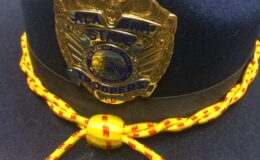
For more than 18 months, mystery has surrounded the discovery of human bones at a rock pool south of Melbourne.
So far, no witnesses have come forward and no-one has been reported missing who is a match for the bones.
But a centuries-old solution may help police identify who was found at Ricketts Point.
Disturbing discovery
Around 5pm on January 11, 2018, two Parks Victoria staff were patrolling Ricketts Point Marine Sanctuary at Beaumaris, around 20kms from Melbourne’s CBD.
Parks Victoria describes the location as “the perfect place to introduce kids to the wonder of Victoria’s underwater marine life”.
But the staff encountered more than marine life in the rock pools that day – they found what looked like human bones, and called Victoria Police.

Their find was made at low tide.
But, with daylight fading and the tide racing in, police acted swiftly, recovering around 400 bones and fragments, equating to about 30 per cent of the person’s skeleton.
The largest fragment, and most readily identifiable as human, was the mandible – the lower jawbone – especially distinctive because the back tooth on either side was missing.
Crime scene?
With the bones secured, teams of police searched the adjacent bush looking for signs of a burial site or any evidence that might give a hint of how the bones ended up on the shore of Port Phillip Bay.

But there were no clues. Police had a mystery on their hands.
Because of the tides, detectives thought the bones may have been placed in the pool not long before discovery – possibly even earlier that day.
In spite of extensive publicity, no witnesses have come forward.
Who is it?
Because the bones were obviously human, the case was treated as a potentially serious crime.
Identification was the first challenge.
Forensic scientists found they were from a female, around 160cms tall, of slight build and around 20 years old at the time of death.

Missing person’s files didn’t yield any leads.
Enter the Victorian Institute of Forensic Medicine (VIFM).
RELATED:
The scientists
Over the past 18 months, the VIFM has exhaustively examined the bones, but still can’t answer one of the most important questions – how long ago did she die?
Nor has their testing been able to give even a glimpse of where she’d come from, or lived, so that investigators might be able to find her name.
Genetic genealogy – extracting a DNA sample from remains, analysing to find genetic markers then comparing the results to genealogy databases – wasn’t possible.

“The bones are in such poor preservation that we cannot get a sufficient profile to determine genealogy,” a Victoria Police spokesperson told 7NEWS.com.au.
Their condition also thwarted the use of phenotyping, in which a DNA sample is used to predict identifying features like height, physique, eye and hair colour.
Police and VIFM’s scientists are stymied.
“Was she left here by loved ones? Was she murdered? We just don’t know,” Detective Sergeant Maurie Ryan told a press conference in July.
“The circumstances of these bones being located are certainly unusual, however we can’t definitively say that it’s suspicious at this stage.”
The Clue
One possible major clue has emerged.
Forensic odontology, in which teeth and dental work are used to identify human remains, and give an idea of factors including age and origin, has been around for centuries.

Old forensic science may hold the key to the Ricketts Point case.
Victoria Police confirmed that the lower jawbone might hold the clue that identifies the young woman.
“There is a tooth and, although in extremely poor condition, it is possible that comparison to the correct dental records may enable us to establish identity,” the spokesperson said.
Police ask that anyone with information contact Crime Stoppers on 1800 333 000 or submit a confidential crime report at www.crimestoppers.com.au.
For more stories from Duncan McNab, click here












